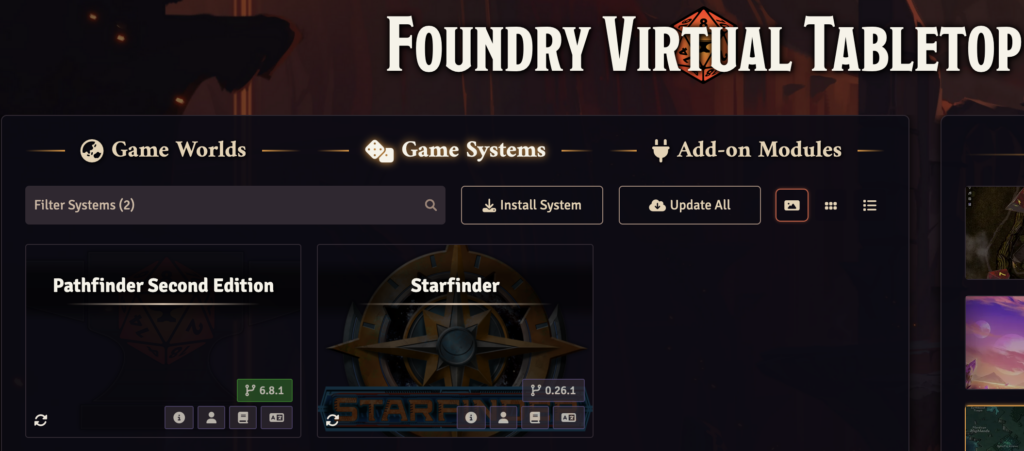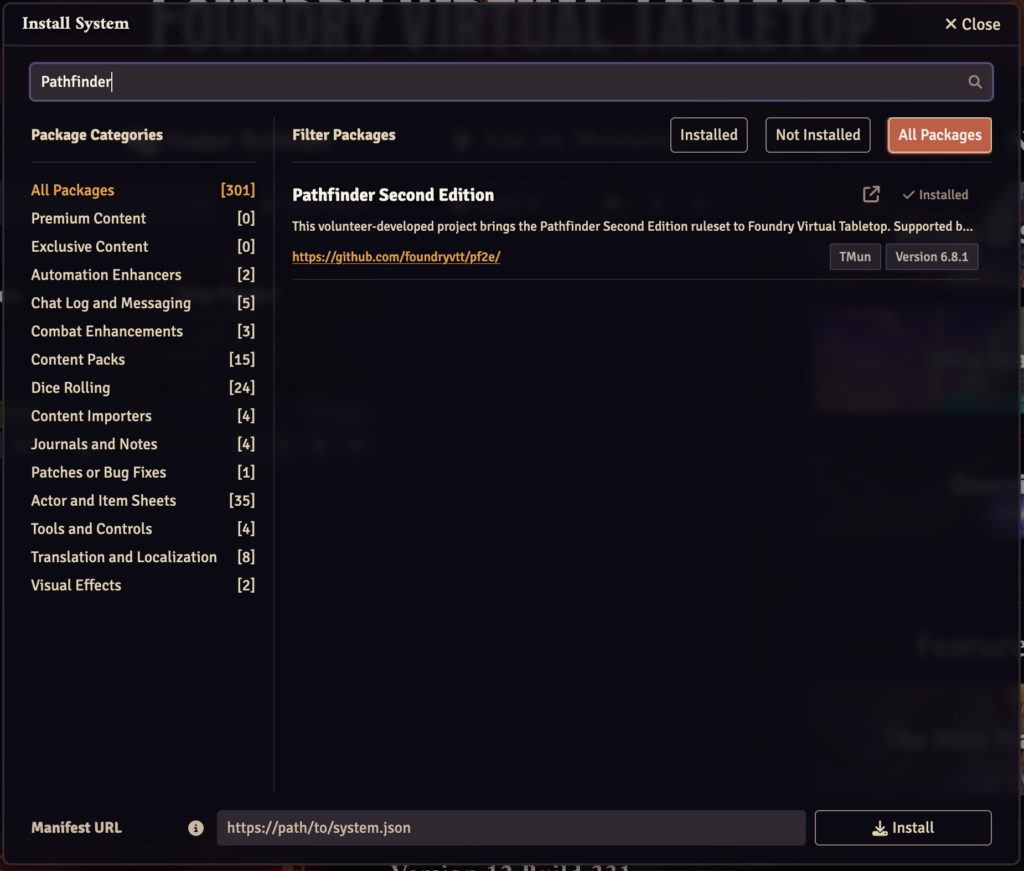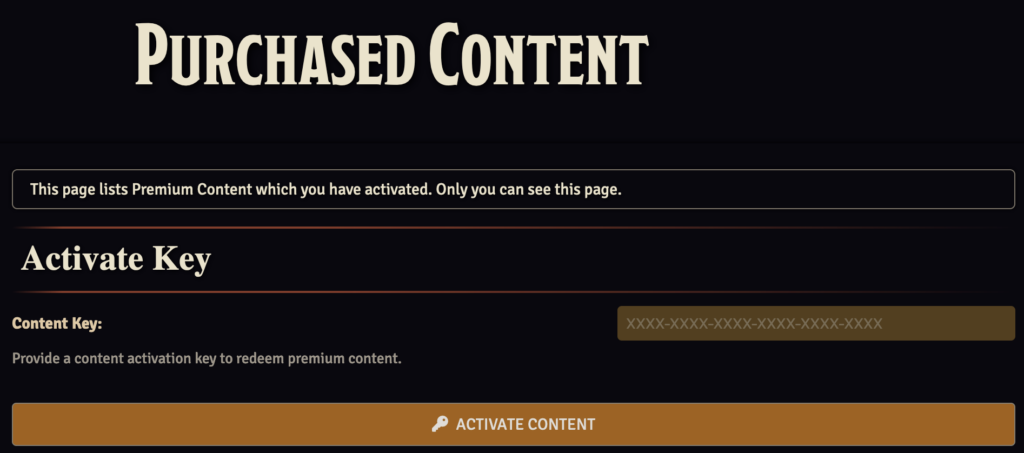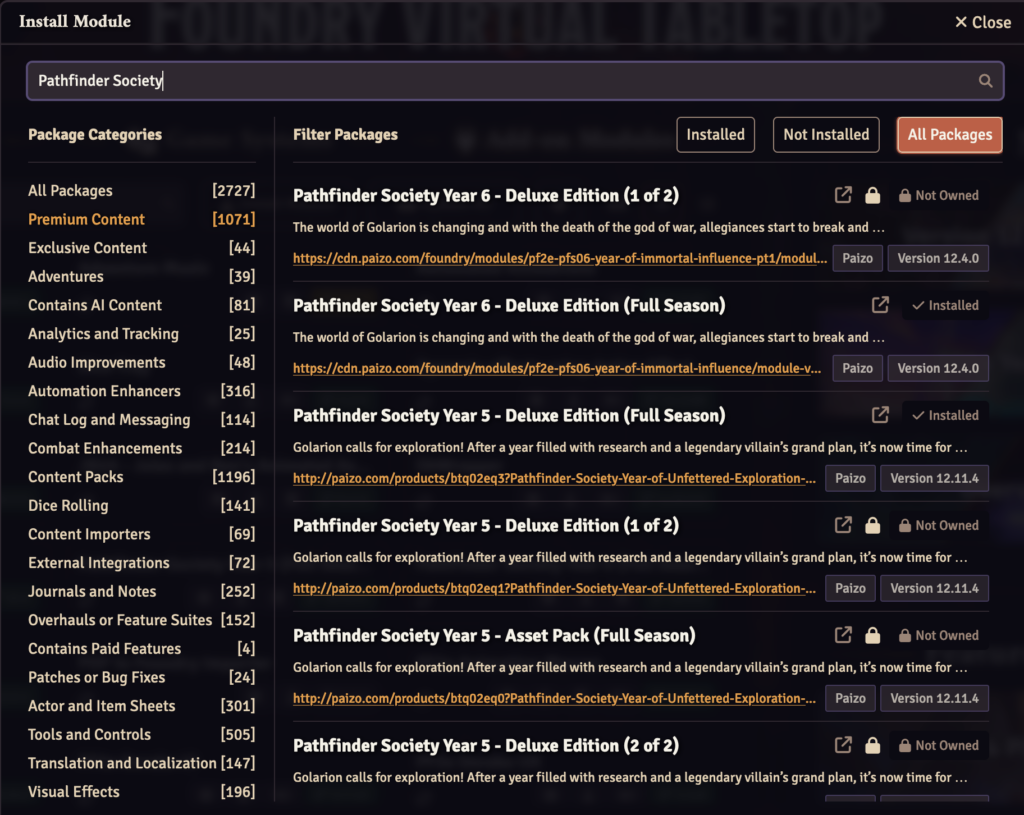Introduction
Sometimes, you might want to run a game of Pathfinder or Starfinder Society online. This was a very popular way of keeping Society going during the COVID-19 pandemic. It is still popular for folks who are geographically distributed.
Foundry VTT is a Virtual Table Top (VTT) software system. It allows players and a Game Master (GM) to access a website together online and play a variety of tabletop games. This guide will take you through from initial conception (“I want to set up a Foundry server!”) to being able to run complete Pathfinder and Starfinder Society scenarios online.
Running Society games online requires some initial setup time. There are several choices to make as you start your Society journey with Foundry VTT:
Where and how will your Foundry be hosted?
Foundry is software that runs on a computer, with a similar hosting model to other website tools such as WordPress, or forums such as PhpBB. That means you must decide where it is going to be hosted (i.e., on what computer?) The main options are:
- Self-hosting: This means you host your Foundry instance on a computer you own at home. Challenges of this method may include finding a suitable computer, installing and configuring Foundry, setting up your network, and cybersecurity concerns. Many home Internet connections are unsuitable for hosting due to bandwidth or packet loss issues. If you have the patience to learn something new, or have previously hosted Internet-facing services from home, this may be a good way to go. Check out this guide for an introduction to the concepts you’ll need to consider.
- Self-managed Datacenter Hosting: You can also rent a general-purpose server, or part of a server, from one of many hosting providers anywhere in the world, then install and configure Foundry on that computer. These rentable servers are usually in professionally managed datacenters, with redundant Internet and power connections, meaning they will be online 24/7, reliable, and usually faster than commodity computers you might own at home. The advantage of datacenter hosting is that you only have to worry about configuring/managing software — all of the hardware is provided and managed for you by the hosting company.
- Colocation: Very similar to Self-managed Datacenter Hosting, except that you own the server hardware and you pay to have it placed in a datacenter and made available online. Prices could be cheaper over time than renting a high-end dedicated server from a hosting company, but to upgrade the hardware, you will need to purchase new hardware. If you’re renting, upgrading the hardware just involves switching to a different hosting plan with the provider.
- SaaS: Going with Software as a Service (SaaS) requires the least technical knowledge or up-front investment of any of the options for hosting Foundry. You just sign up with a website, pay a monthly or yearly fee, and they will host Foundry for you – no questions asked. They’ll give you an easy to follow tutorial for how to start using your Foundry server. Two major Foundry hosts include:
- Forge: Forge is a hosting company that specializes in hosting Foundry VTT. For a monthly or yearly fee, they will create an instance of Foundry VTT just for you and your gaming group.
- FoundryServer: FoundryServer is a competitor to Forge. They have a similar business model: you pay a monthly or yearly fee, and they provide you an easy-to-access, easy-to-use Foundry VTT server.
Costs of Running a Foundry Server
Here is a consideration of the up-front and ongoing costs for each of the above options:
- Self-Hosting: There are at least two major cost centers for self-hosting:
- Internet provider fees: You will need to pay your home Internet bill; but if you’re already paying for it, and you can use the same connection to host Foundry, this method could be “free” (no additional cost to host Foundry). However, your ISP may charge an additional fee for a Static IP, or for additional upstream bandwidth you may want to purchase to provide a high-quality Foundry experience. It’s typical for serious self-hosts to pay an additional $10 to $50 per month on their ISP bill for the above mentioned services.
Depending on whether you decide to purchase these extras, you may end up with a larger Internet bill than before you started self-hosting. However, the cheapest way to self-host is to use Dynamic DNS to point to your Dynamic IP, eliminating the need to pay for a Static IP. If you have a spare laptop or desktop and you are okay with using Dynamic DNS, you might be able to get away with hosting Foundry without any additional Internet provider fees. - Hardware Costs: You need a computer to host Foundry on! That computer might break down or need repairs, and it costs electricity to run. If you already have a spare, reliable computer, this may not be a very frequent consideration, but it’s still not free. At some point you will have to have purchased a computer to run Foundry. A baseline computer with enough processing power to run the Foundry VTT software is probably worth around $500, new or used. You might be able to get away with using cheap, old hardware from a yard sale if it’s reliable.
- Internet provider fees: You will need to pay your home Internet bill; but if you’re already paying for it, and you can use the same connection to host Foundry, this method could be “free” (no additional cost to host Foundry). However, your ISP may charge an additional fee for a Static IP, or for additional upstream bandwidth you may want to purchase to provide a high-quality Foundry experience. It’s typical for serious self-hosts to pay an additional $10 to $50 per month on their ISP bill for the above mentioned services.
- Self-managed Datacenter Hosting: The ongoing costs will be whatever your datacenter host charges on a monthly or yearly basis. Some of the best hosting deals can be found at LowEndBox. Big-name hosts like Amazon Web Services, Google Cloud, and Rackspace tend to be much more expensive than small-time hosting companies, or value-oriented hosts such as OVH and Hetzner. It is possible, but rare, that a hosting company may charge a larger one-time fee to establish service, and then allow you to continue service month to month or annually at a lower price. Typical prices may be as low as $10/month or $100/year for a small Virtual Private Server (VPS), or into the hundreds per month for a highly capable dedicated server. Unless you plan to host multiple Foundry tables simultaneously, you can probably get away with one of the smaller VPSes rather than a dedicated server.
- Colocation: The costs are similar in structure to Self-managed Datacenter Hosting. You are paying for electricity, physical space, Internet access, and security for your server within a datacenter. Typical prices may start as low as $50/month. In addition, you will need to own whichever server you choose to send to the datacenter.
- SaaS: The costs for SaaS are very simple to understand, and shown on the website of whichever SaaS host you choose. For example, as of this writing, the cheapest FoundryServer instance is $4.95/month. The cheapest plan on Forge is $3.99/month if you pay for an entire year at a time, or $4.99/month if you pay monthly. You may desire additional features, storage space or performance that the cheapest plan doesn’t provide; in that case, you may find yourself reaching for one of the more expensive plans.
The Foundry VTT License Key
In all cases, if you are running a Foundry instance, you must purchase a license of Foundry VTT here for a one-time fee. This is true even of SaaS providers.
Paizo Content Licenses
To legally run a Pathfinder or Starfinder Society module, you need to have purchased either a physical or digital copy of that module. This helps Paizo to pay their employees and power their computer systems, so they will be able to produce more content year after year.
Paizo, the owners and authors of Pathfinder and Starfinder, have begun to sell content packs designed specifically for Foundry VTT, which allow you to import Pathfinder and Starfinder Society content directly into Foundry.
You can find all of Paizo’s Foundry VTT content packs here. However, it is not required to purchase their Foundry VTT content packs if you already own the digital (PDF) or physical copies of Pathfinder or Starfinder Society modules. You will need to import the content of your modules “manually” into Foundry, though, which can be time-intensive for complex scenarios.
This gives you two basic options. Do you want to:
- Pay Paizo additional license fees for the convenience to easily use their Society content with Foundry? Or:
- Avoid the extra license fees and import the content (maps, enemy stat blocks, artwork, etc.) by hand?
Regardless of which way you choose, you will need to either invest significant time or money into building out the digital assets for your Society modules in Foundry.
As of January 2025, Paizo only supports a limited number of Pathfinder and Starfinder Scenarios as “Deluxe Edition” packages for Foundry. In addition to all the artwork and maps, these Deluxe packages contain scripts that automatically adjust encounters to scale to the levels of your party. If you / your players are able to purchase these Deluxe Edition packages, they are highly recommended for the easiest GM setup experience and the most seamless player experience.
Setting Up
There are many good guides on the Internet to getting your Foundry server online. Depending on which hosting option you’ve selected, you will have to follow a different process. Start with this guide from Foundry VTT themselves, and look for additional resources on the Internet if you get stuck on a specific step.
Once your Foundry server is online and you are able to login to it, follow the Foundry GM Tutorial to learn the basics of the Foundry interface, and how to set up Actors (such as player characters, NPCs and enemies) and Scenes (maps, animations, etc.)
Regardless of how you intend to build out the content, you’ll need to create a World on your Foundry server. Go ahead and do that. For simplicity’s sake, if you are the only GM running on your Foundry server, you can probably use only one World for all of your Pathfinder Society scenarios. It is recommended to create a separate World for Starfinder Society because it uses a different ruleset.
Installing the Pathfinder Game System
Foundry provides free Game System modules for the Pathfinder 2e and Starfinder 1e and 2e systems. You must install at least one of these to conveniently play by the rules of Pathfinder or Starfinder in Foundry.
To do this, first go to your Foundry server’s setup page (which requires your Administrator Password), then click on Game Systems, then Install System:

In the search box that pops up, search for either Pathfinder or Starfinder, then click Install:

Installing Free Add-Ons – Quality-of-Life for Foundry
The basic Foundry software is convenient and easy-to-use, but a lot of technically-inclined players have decided to develop and contribute their own add-on modules to Foundry to make it even more convenient or aesthetically pleasing.
To install add-ons, go to your server’s Setup page, then click on Add-On Modules, then Install Module.
Based on our experience, here is a list of some common add-ons that are very fun to use with Pathfinder or Starfinder:
- Active Token Effects
- Automated Animations
- Dice So Nice!
- Health Estimate
- Jules & Ben’s Animated Assets
- PDF to Foundry Importer
- PF2e Pathmuncher
- Token Action HUD PF2e
Importing Paizo Society Content – Deluxe Packs
If you choose to purchase Paizo’s deluxe packs for Society, follow this section. If not, follow the next section.
For all of Paizo’s Foundry VTT Content, you will receive a license key from the Paizo web store when you complete your purchase. You must then activate your premium content by logging into Foundry VTT, then click on your user name in the top-right corner, then click on Purchased Content. On this page you will enter your content license key(s) provided by Paizo.

After the content shows up in your Purchased Content list on the Foundry website, you can go into your Foundry’s Administrator backend (“Setup” it’s sometimes called), go to Add-On Modules, then Install Module. Type in the exact name of the module you purchased from Paizo, and you will have a button to click to Install the module.


Importing/Building Society Modules By Hand
If you choose not to purchase the Society modules from Paizo, but you already have the PDF or physical copy of the module, you may manually bring in the content from the module into your Foundry world.
LOREM IPSUM – general instructions for how to build PFS content in Foundry by hand
Importing Player Characters
Players have the following choices when selecting how to build their character:
- Use an Iconic Character: the Pathfinder game system module in Foundry provides all of the Iconic Characters (pre-gens) for free. You can simply go to the Actors list in Foundry, create a copy of an iconic character appropriately leveled, and give control of it to one of your players.
- Manually design characters in Foundry: You can create an empty character sheet for each player character in Foundry, give Ownership of the character sheet to the player who plays that character, and let them configure their character by hand. They will need to pick their ancestry, class, stats, feats, spells, equipment, and decide on a character name, at a bare minimum.
- Import characters from Pathbuilder: If you are not familiar with it already, Pathbuilder is a free, third-party tool that lets you design Pathfinder/Starfinder characters.
To import a Pathbuilder character to your Foundry server, the player who designed the character in Pathbuilder will need to provide you with the 6-digit export ID of your character. Once you have this, open up a new blank character sheet, click on Pathmuncher in the top bar of the character sheet, and paste in the 6-digit ID. It may ask you questions about the character if they were skipped during Pathbuilder’s character design. NOTE: To use Pathmuncher, you first need to install it as an add-on to your Foundry server.
Reporting Your Society Game – For Your Players
Society play involves paperwork. Anyone who has played in-person knows this by the Chronicle Sheet you receive at the end of a session. However, you can largely automate this process online using a website called RPG Chronicles. When properly configured, this tool will automatically email all of your players with a PDF of their completed Chronicle Sheet when the adventure concludes.
LOREM IPSUM – write a guide or link to one describing how to use RPG Chronicles.
Reporting Your Society Game – For Paizo
In addition to giving your players chronicle sheets, you need to report your Society game to Paizo in order for your players to receive credit (XP, Reputation, treasure bundles, etc.) that can be used either in-person or online.
LOREM IPSUM – add detail on how to report online.
